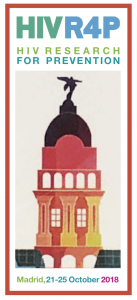Dual bNAb maintains viral suppression for median 21 weeks off-ART
13 November 2018. Related: Conference reports, Antiretrovirals, Treatment strategies, R4P 2018 Madrid.
In the first presentation in a session at R4P2018 looking at using bNAbs for prevention, Pilar Mendoza from the Rockefeller University presented results on the impact of a combination of two antibodies in HIV positive people on ART who then took an analytic treatment interruption (ATI). [1]
The two bNAbs, 3BNC117 and 10-1074, target non-overlapping epitopes and provide broader coverage. All 11 participants were initially screened for sensitivity to both antibodies (there was an approximate 50% rate of failing screening) and were on effective ART.
ART was stopped two days after the first dual infusion, with additional infusions at weeks 3 and 6 when off ART.
The reservoir was measured at the first infusion and at 12 weeks (when suppressions was still expected) and the criteria to restart ART was two consecutive viral load results >200 copies/mL or at 30 weeks, whichever was sooner.
Viral suppression using the dual bNAbs resulted in median 21 weeks to viral rebound >200 copies/mL, which was significantly longer compared to historical controls or previous single bNAb studies (p <0.0003). Two participants were still virally suppressed at week 30.
However, 2/11 participants were later found to have preexisting bNAb resistance in the viral reservoir that was not detected at baseline, and both responded with similar early viral rebound to monotherapy studies.
Analysis of the time to rebound in the 9/11 sensitive participants showed this closely linked to when plasma levels of 3BNC117 fell below estimated therapeutic concentrations of 10 ug/mL, leaving a window of monotherapy to 10-1074 due to it’s longer half-life. This also meant that rebound virus tended to show resistance to 10-1074.
Some participants also rebounded after both antibodies were cleared. No cases of double resistance were reported.
No reduction in the viral reservoir was seen between baseline and week 12.
Previous studies using 3BNC117 monotherapy delayed viral rebound by approximately nine weeks.
comment
These tentative results show an exciting potential for combination bNAbs therapy to maintain viral suppression off-ART.
However, the rapid rebound with antibody resistance during periods of effective monotherapy is an important caution for future research.
This also creates a challenge for considering pharmacokinetic profiles of different molecules when used in combinations.
Reference
- Mendoza P et al. Combination of HIV-1 antibodies 3BNC117 and 10-1074 delays viral rebound during treatment interruption. R4P2018, 21-25 October 2018, Oral abstract OA08.01.
http://webcasts.hivr4p.org/console/player/40352 (webcast)


 Simon Collins, HIV i-Base
Simon Collins, HIV i-Base